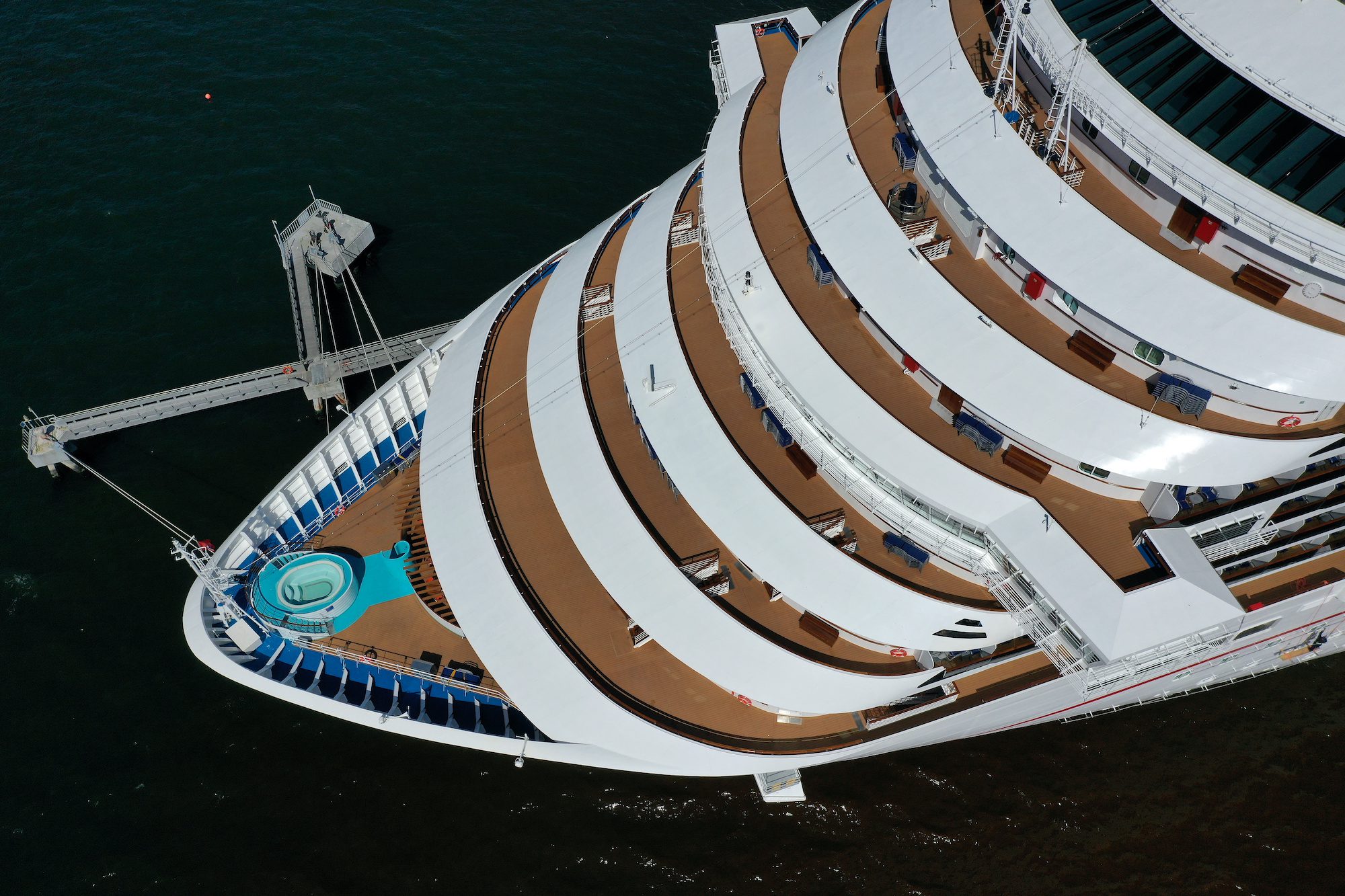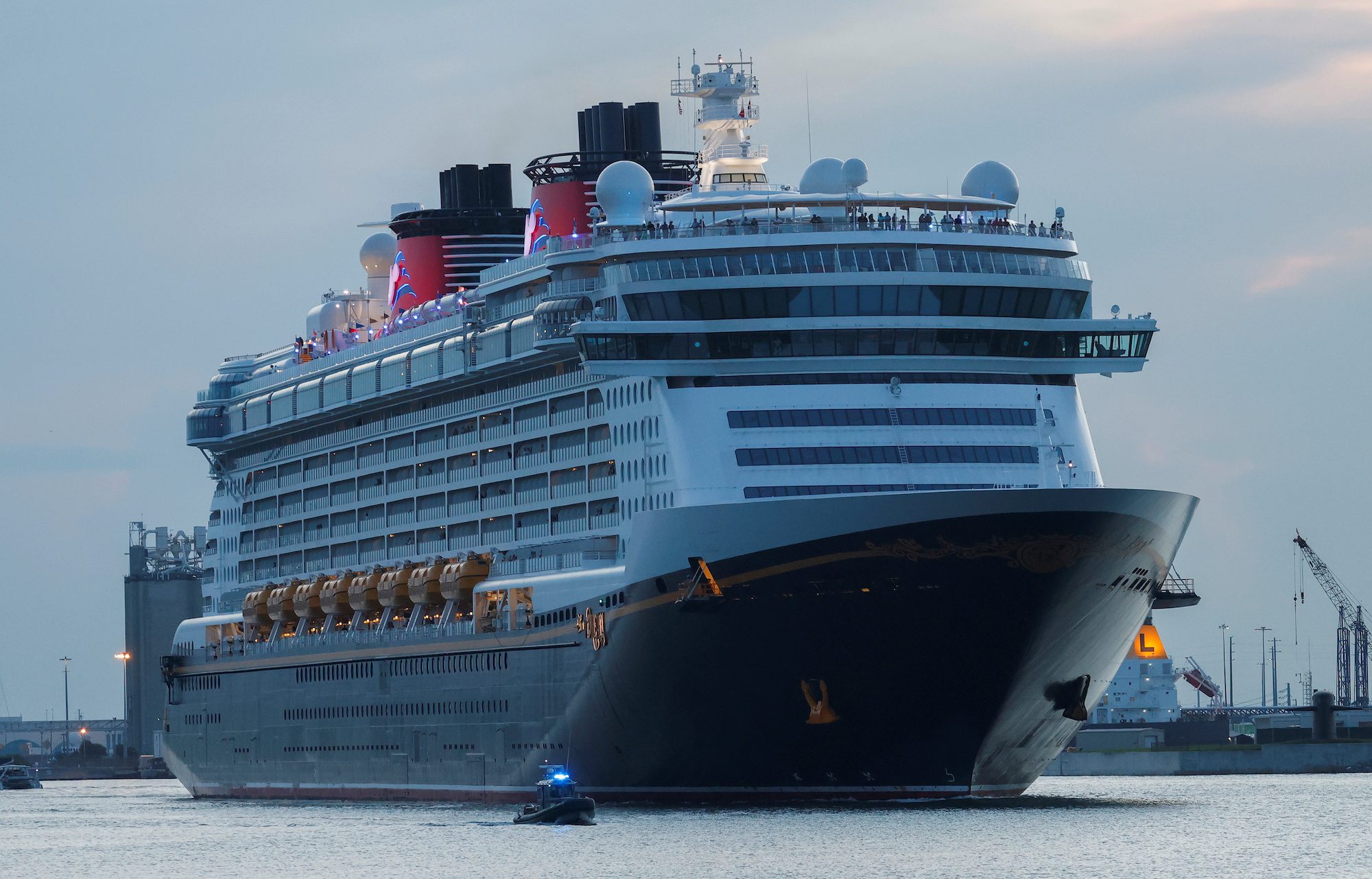(Bloomberg) —
When Royal Caribbean’s Icon of the Seas embarks on its first official voyage on Jan. 27, the journey is sure to make waves. The world’s largest cruise ship, the Icon is over 1,000 feet long (360 meters) and weighs in around 250,000 gross registered tons. It boasts 20 different decks; 40 restaurants, bars and lounges; seven pools; six waterslides and a 55-foot waterfall. Royal Caribbean says its boat will usher in “a new era of vacations.”
Maybe so. But the Icon is also a doubling down on a negative aspect of cruising’s current era: greenhouse gas emissions.
In 2022, Bryan Comer, director of the Marine Program at the International Council on Clean Transportation examined the carbon footprint of cruising as compared to a hotel stay plus air travel — since cruises are effectively floating hotels. His analysis found that a person taking a US cruise for 1,200 miles (2,000 kilometers) on the most efficient cruise line would be responsible for roughly 1,100 pounds (500 kilograms) of CO2, compared with 518 pounds (235 kilograms) for a round-trip flight and a stay in a four-star hotel. In other words: Taking a cruise generates “about double the amount of total greenhouse gas emissions” as flying, Comer says.
Not to mention, “usually people fly to take a cruise,” notes Stella Bartolini Cavicchi, marine policy advisor at OceanMind, a nonprofit that uses satellite and other technologies to understand humans’ impact on the sea. Flying to a cruising port means you “end up with quite a carbon-intensive holiday,” she says.
A Royal Caribbean spokesperson says the Icon is designed to operate 24% more efficiently than the international standard for new ships, which per International Maritime Organization (IMO) regulations must already be 30% more energy-efficient than those built in 2014. The company will also monitor the Icon “over the next six to 12 months to ensure that we’re getting what we were designing the ship to be,” the spokesperson said.
In 2022, the most recent year for which data is available, Royal Caribbean direct (or Scope 1) emissions totaled 5.5 million tons of CO2 equivalent, up from 5.3 million tons in 2019.
Just a few years ago, the future of cruising seemed like it was in dire straits. When Covid-19 travel restrictions grounded ships for months on end, there was major concern in the industry that passenger interest would be slow to return. But as soon as restrictions were lifted, “people did not think twice,” Bartolini Cavicchi says. “The Oceania world cruise sold out within one day in January 2021. People were just dying to get back out there.”
The Cruise Lines International Association (CLIA), which says its membership accounts for roughly 95% of global cruise trips, predicts passenger volume will hit 36 million this year, up from almost 32 million in 2023 and 30 million in 2019. Last year, the ClimateTrace coalition (of which OceanMind is a member) published an analysis that found cruise ship emissions are already 6% higher than they were before the pandemic.
Cruise ships’ climate impact isn’t limited to emissions that trap heat in the atmosphere. The enormous vessels also spew a soot-like substance known as black carbon, which absorbs sunlight and traps heat on the ground. In the Arctic, which is playing host to a growing number of cruises, black carbon can settle on snow and ice, speeding up the rate at which glaciers melt. Bartolini Cavicchi says that while cruise ships account for around 1% of the global fleet, they’re responsible for 6% of black carbon emissions.
Unlike flying, whose climate impact spurred flygskam, or flight-shaming, cruise ships don’t always get the same environmental scrutiny. That’s in part because shipping is often seen as more energy-efficient than air travel, which is true for cargo ships thanks to their relatively small living areas and efficient use of space. Cruise ships, by contrast, are energy hogs: Paying vacationers expect more square footage, and modern cruises offer a slew of amenities.
“You’ve got things like heating the pool and keeping the lights on,” Comer says. “[You] have heating and air conditioning; you’ve got the casino. There’s just a lot of equipment to keep running to keep everybody entertained and comfortable.”
At the same time, cruise companies are quick to cite sustainability goals. Royal Caribbean Cruises, MSC Cruises and Norwegian Cruise Line Holdings have all pledged to reach net zero emissions by 2050, while Carnival Corp. plans to achieve carbon neutrality by 2050.
To meet those goals, cruise operators are increasingly replacing oil-based fuels with less carbon-intensive alternatives, most commonly liquified natural gas (LNG). The CLIA says that, of the 44 new vessels on order through 2028, more than half will be powered by natural gas. The Icon of the Seas runs on a 300-ton LNG fuel tank.
LNG-powered ships do emit 25% less CO2 than those running on conventional marine fuels, but one 2023 investigation by environmental activists found that cruise ships running on LNG often leak some of it directly into the atmosphere as methane, a greenhouse gas that in the short term is 80 times more potent than carbon dioxide. For three out of four engine types, the investigation determined that LNG was worse for the climate in the short term than conventional fuels.
Comer says cruise ship operators could transition to more sustainable fuels. Replacing LNG with methanol — an alternative that can be made to have little to no lifecycle emissions — would slash methane output.
The Royal Caribbean spokesperson says that when the Icon was designed eight years ago, LNG was the “next new-age fuel for any ship” and the vessel’s engine was the most efficient option. The company’s next ship — the Utopia of the Seas, slated for completion this spring — will have a different engine designed to reduce the risk of methane leaks. The Celebrity Xcel, which is part of Royal Caribbeans’ Celebrity subsidiary and expected to begin operations in 2025, is being designed with an engine that can run on three kinds of fuel, including methanol.
The maritime industry overall is under pressure to cut emissions. Last year, the IMO began requiring companies with ships over a certain size to calculate an Energy Efficiency Ship Index (EEXI) and to begin collecting data related to an operational Carbon Intensity Indicator (CII), which factors in a ship’s emissions, the amount of cargo being transported and the distance traveled. Starting this year, ships will receive an A to E sustainability rating based on their data; those with a D rating for three consecutive years, or an E for one year, will have to submit a plan for improvement, though it’s unclear what penalties there are for poor performance.
But the cruise industry is pushing for a metric that doesn’t factor in distance traveled, as cruise ships’ time in port means they’re likely to receive a worse CII rating. The vessels’ hotel-like infrastructure still requires significant energy use even when there are fewer people on board and no nautical miles being traversed. “The metric is not is not set up for ships that do not move continuously,” says the Royal Caribbean spokesperson.
Recent research indicates this inconsistency could even incentivize cruise ships to adopt itineraries with more time on the move, which would increase their overall emissions. The authors suggested replacing distance traveled with percentage of time spent at sea.
© 2024 Bloomberg L.P.

 Join The Club
Join The Club










